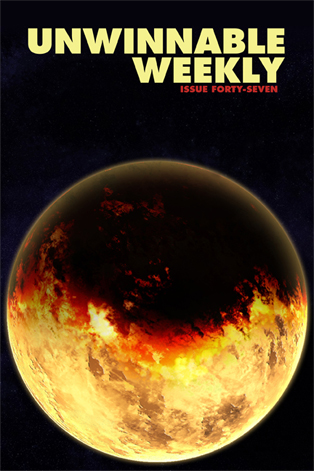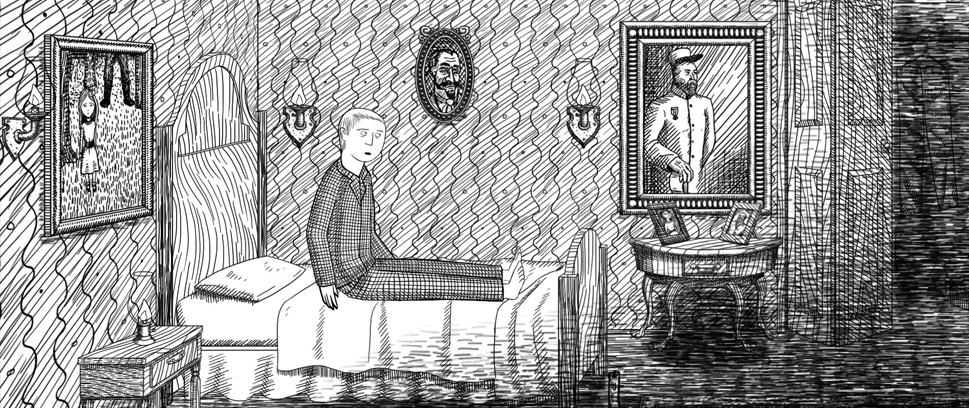
Books and Their Covers

The Burnt Offering is where Stu Horvath thinks too much in public so he can live a quieter life in private.
———
The following is a reprint from Unwinnable Weekly Issue Forty-Seven. If you enjoy what you read, please consider purchasing the issue or subscribing.
———
From where I sit, a ten-minute train ride from 21st century Manhattan, the idea of arranged marriage is an utterly foreign one. Yet it was the norm in the West for centuries and continues to be accepted today in many parts of the world. So, let’s pretend that this is not an outrageous idea. Imagine that the financial and political fortunes of your family depend upon this kind of matchmaking.Let’s pretend for a moment that you are living in the 16th century. You are either of noble stock or come from a family that belongs to the growing merchant class that has enough money to pretend to be nobility. You have just reached majority and it is now your duty to marry.
The hard work falls to your father. He has to measure the needs of the family against available matches but frankly, it is slim pickings in town. It makes sense to look farther abroad – international alliances are lucrative, after all. Travel, though, is difficult, dangerous and, most of all, time consuming. It wouldn’t do to have an heir suffer the depredations of the road. It would be foolish to risk maidens to the highwaymen. How, then, to get a sense of the candidates without meeting them in person?
There is correspondence, of course, great piles of it, but it is important to look a person in the eyes, get a measure of their breeding, see the shape of their skull. So, you and your matches sit for portraits. The paintings make the journey so you don’t have to. Here are your potential future mates, in vibrant oils, in dramatic lighting, in their finest clothes, their head turned to show off their best features. You can fall in love or dismiss people you’ve never met, half a world away.
Assuming, of course, that the painter didn’t embellish his work.
I mean, who would do that?
* * *
The idea, from the game developer’s standpoint, is to start building favorable hype ahead of release, to fuel pre-orders and woo future sales. To this end, the demo that plays out is not really representative of the final game, but rather it represents a kind of Platonic ideal of the game that PR hopes will appeal to consumers.When a videogame exists in that gestational period between announcement and release, there comes a time when it rears itself up, embryonic, and presents itself to journalists. This usually happens at a preview event of some kind, be it at the office of the game studio, a rented bar or huge industry conference.
Again: the demo does not represent the final game. Demos at shows like E3 get their own development cycle, complete with crunch time, in order to ensure that the most dazzling, most polished and, above all, most on-message experience gets into the hands of those most willing to trumpet it to the masses.
There are a few basic types. There’s the game trailer, which is not unlike a movie trailer, usually a mix of game and cutscene footage edited to convey a sense of awe. There’s the guided demo, where a rehearsed developer plays through a canned section of game for an audience, usually with running verbal commentary. Then there’s the hands-on, a brief demo that can be played at its own pace.
These are simulacra, fuzzy prophecies of what may eventually be. Countless games have run afoul of their own overly optimistic demos. Games like Watch Dogs, Dark Souls 2 and the recent The Witcher 3: The Wild Hunt are all recent examples. Some, like Star Wars 1313 and Prey 2, never see the light of day.
* * *
There is an undeniable appetite for outlets to run preview stories. The recent frenzy over the announcement of Fallout 4 is the perfect illustration of this. The initial PR salvo was merely a confirmation that the game was in development accompanied by a countdown clock. That is all it took to make Twitter explode with a fever pitch of chatter and speculation. A brief leak of the official Fallout 4 website, followed by the release of a teaser trailer, were met with equally fervent explosions of conversation.Game demos are not marketing tools in the traditional sense. Unlike movie trailers, book excerpts and similar teasers, game demos and presentations rarely face the public directly, at least not in a meaningful way. They are almost exclusively presented to journalists. The metaphor that immediately comes to mind is the pope interpreting the word of God to the faithful masses.
As of this writing, no one outside the development studio has actually seen the game, let alone played it. All of this sturm und drang is for one vague fact: Fallout 4 will exist, eventually, at a date not yet revealed.
Bethesda will certainly release more on Fallout 4 at E3 – I’ve already seen the obnoxious #BE3 hashtag floating around. Legions of games journalists will march into the press conference, see the demo reel, talk to the on-message developer and dutifully file their preview stories for the hordes of readers who want to learn more.
But what is there to report? Unless there is a catastrophic breakdown in the PR wall, everything presented to journalists is tailor made to ensure that it shows the potential game at its very best. It is nearly impossible to be critical of something that is glimpsed only in short bursts and sound bites. Everything runs with the disclaimer that the game is still in development. Found a problem? We’ll fix that before launch, you can bet on it. We promise.
* * *
Can previews be interesting and serve the reader? Sure. I love reported, behind-the-scenes features. I love hearing people talk about the process of creation, the successes and failures and surprises, while in the midst of creating. There is value in hearing people candidly explain what they are trying to accomplish before it is accomplished, but these things require transparency on the part of PR and more effort on the part of writers than most are willing to devote for the pay. don’t read previews. I especially hate writing them. It is unusual to find anything resembling an interesting or creative angle, at least at the speed I digest and form opinions about cultural artifacts. And, honestly, I resent being spoon-fed the same gruel as every other writer from every other outlet. In their current form, at best, previews are just shy of advertorial writing and at worst they are rose-colored hack work. In both cases, I think they do a disservice to readers, no matter how badly those readers want to read them.
Instead, we have the preview as it currently is, 1,000 or so words, the first two thirds of which recount the event as the most tedious travelogue (“I push the button. My character swings his sword. The blood spatter is satisfyingly visceral.”) while the final third flails around for some kind of takeaway that isn’t just advertising copy.
Keep in mind, for most gaming websites, the preview is part of a holy trinity rounded out by news and reviews. It is a full third of what accounts for the traffic and reach necessary for such outlets to sustain themselves. Stories equal visitors, visitors equal advertising views, advertising views equal revenue. There is a bit more sleight of hand in that algebra, but you get the idea.
To run a gaming site of a certain size, the holy trinity of previews, reviews and news is your bedrock. Do away with them and your traffic will plummet, taking your ad revue with it. Some sites use this churn to fund feature writing. That’s the kind of writing that writers are passionate about, but it is a poor return on the investment when a regurgitated press release clocks more reads by a factor of ten.
Worse, as sites like Buzzfeed and UpWorthy cracked the idea of viral content, the bar for attracting advertising revenue is exponentially higher now than it was even three years ago. Small to medium sized sites, even those running with the trinity, can’t hope to compete, no matter how much they churn. New voices and new ideas fall to the wayside in the struggle to survive.
What I am saying is that this is a self-reinforcing system and we are probably past the point we could change it, even if everyone wanted to.
* * *
Then I asked Twitter, “Why do we still do previews and how do we stop?”The other day, I asked Twitter if anyone knew another medium that puts unfinished creative work before journalists as part of a marketing strategy. The only compelling answer came from Claire Hosking, who mentioned architectural maquettes used to sell people and politicians on building projects.
Rob Rich, editor in chief of 148Apps, confirmed some of my suspicions, saying, “Sad truth: page views.”
When I asked why page views are the internet’s gauge for merit and quality, he replied, “Because archaic income methods that are more or less irrelevant but everyone refuses to change?”
Dennis Scimeca of the Daily Dot echoed Rob, saying, “Without previews, I think pure enthusiast sites would have content holes they could not fill.” He went on to question the obsessive secrecy of the industry’s PR, asking, “What, precisely, are the industry-shaking secrets that one must protect at all costs, or sales will suffer?”
Tom Ohle, director of Evolve PR and writer of this interesting defense of the preview, said, “It’s an odd situation in this industry – the current model relies on pre-release hype or big ad budgets. I’d say that it’s feasible for game devs to save their marketing budget for ads at launch and succeed. Maybe.
“It’s a systemic issue. [On the development side] it will take big-budget examples to shift thought. And if there’s one thing big-budget devs don’t like, its risk.”
Unwinnable contributor Jeremy Signor thinks a lot of systemic problems with the hype cycle come from smaller sites trying to mirror the metrics of big sites. “Used to be, the big boys were the ideal, the dream. Either you wanted a site as big as them, or you wanted to work for them,” he said, “That sentiment’s still around, but now it’s more of a myth, a trap. The bubble burst.”
Ben Silverman, senior editor at Yahoo Games, said, “Traffic is a measure of reach, and in turn, revenue. Every site needs traffic. I spent a decade co-owning an enthusiast publication. Lived and died by the CPM [cost per mille – a measurement used in ad campaign, literally the cost of advertising per thousand impressions – editor], but we also trusted our work.”
When I mentioned how cheap the payout for advertising was these days, compared to five years ago, Ben replied, “This is why I no longer co-own an enthusiast pub.”
Perhaps most optimistically, Conrad Zimmerman of Destructoid and the Escapist sees the preview as a potential tool for change. “It’s supposed to be the writer’s job to be able to parse [promotional] information and provide larger context. Truth hurts. People don’t like to take medicine, but you just have to take that spoon and shove it down their throat from time to time.”
“And if that pisses them off, well, that sucks. We have to accept that as a part of the gig. It’s more important to be honest.
“And maybe that’s how it stops. If you’re honest enough, they just won’t invite you anymore. Job’s done.”
* * *
Perhaps previews don’t need to go away, but rather our approach to them needs to be rethought, revised. There is a certain appeal to discussing what might be, the same way we did in the school yard. We are all looking for things to fall in love with. still don’t know for sure what to think. I understand why the preview cycle is what it is. I understand why PR people wield the power they do (it is their job) and why journalists write what they do (also their job). In fact, the more I think about it, the more I think this isn’t about money or hype or some decay in the state of cultural criticism. I think, maybe, this is just how people work. The world tells you not to judge books by their covers, be we do, all the time, repeatedly. Game developers and journalists have just taken that to its logical conclusion, made an industry out of it.
It all goes back to those marriage portraits. At a glance, it seems so outlandish to agree to get married based on a few letters and portrait. But is it really?
My girlfriend Daisy and I met on OKCupid. The very first thing I encountered about her was her photo. I made a series of judgements based on that photo, some conscious, others not so much. I did that before I read a single word of her profile. For some reason, that doesn’t seem like a strange thing to do.
After I read her profile, I took a few minutes to look at the questions she answered. OKCupid’s matching algorithms are highly dependent on the questions you answer about yourself – have a lot of questions in common and you’ll get a decent match rating. There are thousands of possible questions, so the questions you have in common is usually a small portion of the total questions you have answered.
I went through all the questions Daisy answered and answered the ones I had not filled out previously. Answered every one. I wanted to see if that made our match rating go up or down.
It went way up.
I answered honestly, but I am not entirely sure that was an honest thing to do. It seemed, then and now, like I was gaming a system. A bit of self-promotional hoodoo, though Daisy can’t honestly recall if it influenced her decision to meet up. We did, though. I was goner from the first date.
We’re getting married in October.
———
Stu Horvath is the editor in chief of Unwinnable. He reads a lot, drinks whiskey and spends his free time calling up demons. Sometimes, he plays with toys and calls it “photography.” Follow him on Twitter @StuHorvath.




